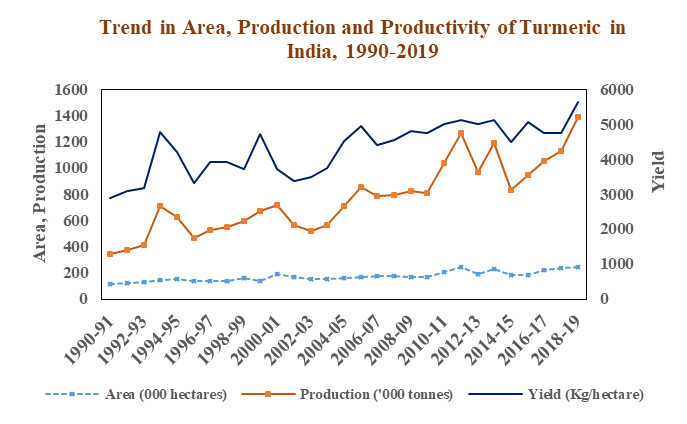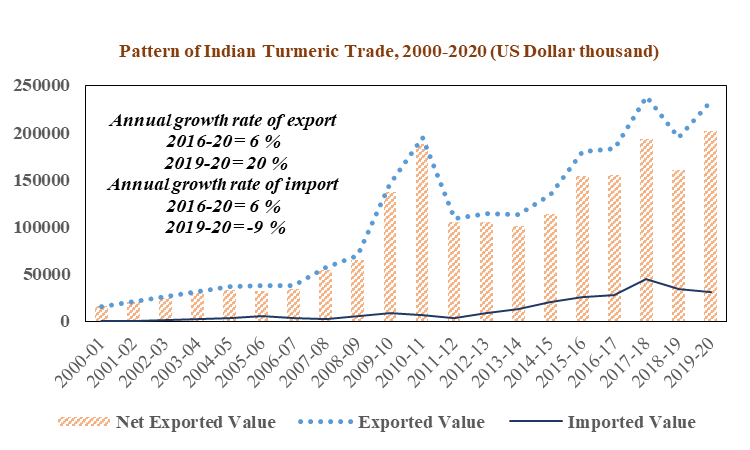

Introduction
As an important spice, turmeric is growing in India since ancient times mainly for its culinary and medicinal properties, particularly in Ayurveda. Various property of this spice has extended its use as a component of food additive and other natural dies, also as a clinical component in the cosmetic and pharmaceutical industries and many other uses. A recent pandemic, COVID-19, also further valued the health benefits in the form of an immunity booster. For India, this gives immense benefit as one of the important producers and also a major global exporter to not only benefit economically also to serve the globe in a better way. Additionally, the greatest diversity of this spice in the form of a number of species (around 40 to 45) is a great advantage to bring new innovations and its derivatives.
Market Trends
The performance of turmeric within the country in terms of area expansion and production and global performance can be visualized from figure 1. India being one of the major producers of turmeric, contributes 80% to global production. In the year 2018-19, turmeric production was 389 thousand tonnes, with area and productivity 246 thousand hectares and 5646.34 kg per hectare respectively. The growth pattern of the area, production, and productivity of turmeric over the period of time indicate the growing contribution of production over the area expansion to the increased yield. In the international market, India is a net exporter of turmeric and earned 201,152Thousand US Dollars in 2020. The USA is the largest consumer of Indian turmeric, imported 22 percent of the total exported value, followed by Bangladesh (18%), Iran (6%), and UAE (5%) in the last year. Some of the other importing countries are Malaysia, UK, Morocco, Germany and Japan. As already mentioned, the COVID-19 pandemic particularly elevated turmeric sales, both in the form of fresh and dried. Also, turmeric is used as one of the common ingredients in daily uses grocery for example as turmeric jaggery. The sale has been also appreciable in the international market i.e. the exported value of the turmeric jumped to 20 % in the last year as compared with 6% growth in 2016-20. This opportunity can be utilized further by introducing some new innovative products and recipes. In this way, northeastern states can also benefit large that we discuss briefly below.
Opportunity for north-eastern states to prosper by turmeric cultivation and marketing North-eastern states, particularly Mizoram and Sikkim are recognized as abnormally high productivity states in turmeric cultivation because of their higher yield. Also, they have the advantage of recognition for organic production. In addition, under the National Mission for Sustainable Agriculture (NMSA), the Ministry of Agriculture and Farmers Welfare launched Central Sector Scheme, Mission Organic Value Chain Development for North East Region (MOVCD-NER) to support the development of value chain starting from input supply, certification, to the creation of facilities for aggregation and processing of the product. There are 33 clusters in Manipur operating under MOVCD-NER, also Assam and Sikkim have better geographic coverage of FPOs (Farmer Producer Organizations). By promoting such practices in other north-eastern states, they can exploit this niche market in near future.
Another important policy strep i.e. “One District One Product” under Centrally Sponsored Scheme PMFME (PM Formalisation of Micro food processing Enterprises Scheme), Turmeric is listed in the selected product in all of the North-eastern states, this is an additional scope under which states can be encouraged to adopt cluster approach and group approaches such as FPOs, SHGs (Self Help Groups) and producer cooperatives. This will help to bring the win-win situation to both farmers and the microenterprises. Also, except Assam, the spread of formal/organized food processing units are scanty, the innovation center for developing value-added products from the traditional knowledge can be encouraged so that in the long run the product can be easily scaled up.


Figure 1: Progress in production and trade of Turmeric in India
References
Annual Survey of Industries. (207-18), Ministry of Statistics and Programme Implementation, Government of India, New Delhi.
Area production statistics, Horticulture crops (various years) National Horticulture Board, Ministry of Agriculture and Farmers Welfare, Government of India.
https://mofpi.gov.in/pmfme/support-fpos-shgs-producer-cooperatives https://mofpi.gov.in/sites/default/files/odop_list_of_35_states_and_uts.pdf UN COMTRADE and ITC statistics.
(Content shared by Nithyashree M.L. Ph.D., ARS, Scientist (SS), Division of Agricultural Economics, ICAR-Indian Agricultural Research Institute, New Delhi)